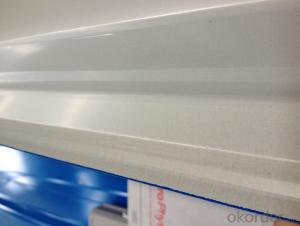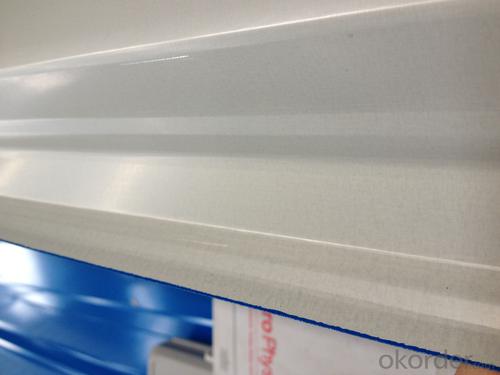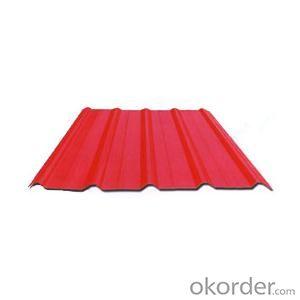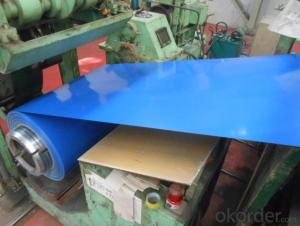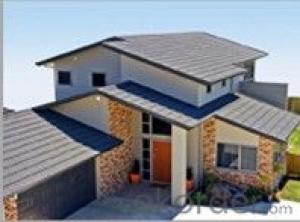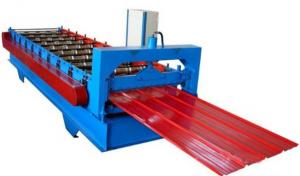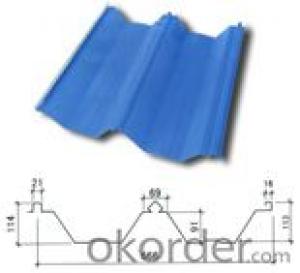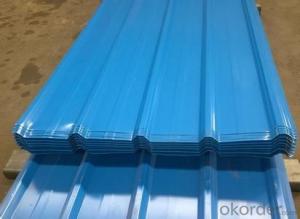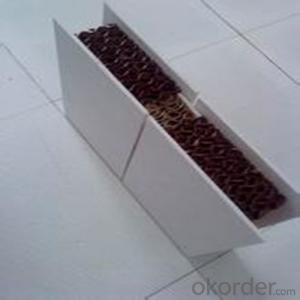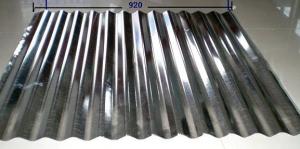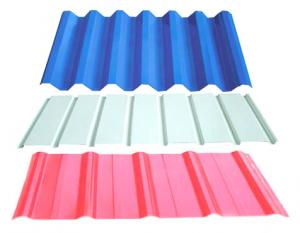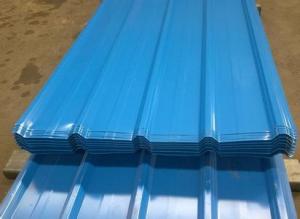Corrugated color Pre-painted Steel Sheet
- Loading Port:
- Tianjin
- Payment Terms:
- TT OR LC
- Min Order Qty:
- 50 m.t.
- Supply Capability:
- 1000 m.t./month
OKorder Service Pledge
OKorder Financial Service
You Might Also Like
Corrugated color Pre-painted Galvanized Steel Sheet
Description:
The production process has evolved from one-coating-and-one-baking to double-coating-and-double-baking, and even three-coating-and-three-baking.
The color of the Pre Painted Steel Coil has a very wide selection, like orange, cream-colored, dark sky blue, sea blue, bright red, brick red, ivory white, porcelain blue, etc.
Pressing steel panel with the clear line, and many colors for choice, suitable for any different building style materials, achieving satisfy effects;
Pressing steel panel can be freely incised, it can satisfy the especially designing demands. It apply on convenient construction, and anti-seismic performance, fire proof, waterproof, free of maintenance, ect.
Base sheet : galvanized steel sheet, pre painted galvanized steel sheet
Application:
Corrugated steel sheet is the colored steel plate which has been wave formed with the cold rolling treatment, trough especial coated dispose, the color coated steel panel’s guaranty is 12-15 years.
It has been widely applied on civil construction like storerooms, special building roof and walls of wide-span steel structure building and so on.
With excellent cold bending molded manufacturablity, good decoration effect, strong anti-corrosion ability, are also pollution-free and easily recycled. Accordingly, they can be used as final products and basic plates of color coated steel coils and widely applied in construction, home appliances, decoration, ect.
Product Specification:
Paint: PE or PVDF
Width and Thickness: width within 1000mm, thickness from 0.23-0.8
Color pre painted steel in coil
Zinc Coating: 50-180g/m2
Top coating:5 mic epoxy+20 mic
Back coating: 7 mic epoxy grey
Standard:JIS G3312,CGCC
Package:Standard seaworthy export packing: 3 layers of packing, inside is kraft paper,water plastic film is in the middle and outside pallets.
FAQ:
1.How many pieces for one package and the weight for one package?
The pieces for one tone is decided by the thickness of the sheet, but we can make it according to your requirements in the reasonable range.
Usually 2-3 tons for one package.
2. Could you provide special coulor for the sheet?
Yes, we can produce the goods according to the customer’s requirements.
3. Can you design the label according to our requirements?
Yes, we can. You just need to provide us the picture.
- Q: How are steel sheets protected during cutting and fabrication?
- Steel sheets are protected during cutting and fabrication through various methods such as using protective coatings, applying lubricants, and utilizing automated cutting technologies. These measures help prevent corrosion, reduce friction, and ensure precise and efficient cutting without compromising the quality and integrity of the steel sheets.
- Q: What are the benefits of using pre-painted steel sheets?
- There are several benefits of using pre-painted steel sheets. Firstly, they offer a wide range of colors and finishes, allowing for greater design flexibility. Secondly, pre-painted steel sheets are highly resistant to corrosion, providing long-lasting durability. Additionally, they require minimal maintenance, as the paint coating acts as a protective layer against damage and weathering. Furthermore, pre-painted steel sheets are easy to install and can be used in various applications, including roofing, siding, and construction. Overall, their aesthetic appeal, durability, and low maintenance requirements make them a preferred choice in many industries.
- Q: Can steel sheets be used for food processing applications?
- Yes, steel sheets can be used for food processing applications. Stainless steel sheets are commonly used in the food industry due to their corrosion resistance, durability, and ease of cleaning. They are suitable for various food processing equipment, such as conveyor belts, countertops, food storage containers, and cooking surfaces.
- Q: What are the different surface protection methods for steel sheets?
- There are several different surface protection methods for steel sheets, including painting, galvanizing, powder coating, and applying protective films.
- Q: What are the different types of steel coatings for sheets?
- There are several types of steel coatings for sheets, including galvanized coatings, zinc-aluminum-magnesium alloy coatings, tin coatings, and polymer coatings.
- Q: Can steel sheets withstand extreme weather conditions?
- Yes, steel sheets are designed to withstand extreme weather conditions. Steel is known for its strength and durability, making it an ideal material for withstanding harsh weather elements such as high winds, heavy rain, snow, and extreme temperatures. Steel sheets are often used in construction, roofing, and outdoor applications where they are exposed to various weather conditions. Additionally, steel sheets can be coated with protective layers such as galvanized or painted finishes, which further enhance their resistance to corrosion and weathering. Overall, steel sheets are highly reliable and can endure extreme weather conditions with minimal damage or deterioration.
- Q: What are the different sheet metal welding techniques for steel sheets?
- There are several different sheet metal welding techniques that can be used for steel sheets. Some of the most common techniques include: 1. Gas Metal Arc Welding (GMAW): Also known as MIG welding, this technique uses a continuous wire electrode to create an arc and join the steel sheets together. It is a versatile and efficient method, suitable for both thin and thick sheets. 2. Gas Tungsten Arc Welding (GTAW): Commonly referred to as TIG welding, this technique uses a non-consumable tungsten electrode to create an arc and join the steel sheets. It produces high-quality welds with excellent control and is often used for thin or delicate sheet metal. 3. Resistance Spot Welding (RSW): In this technique, two electrodes apply pressure and pass a high electrical current through the steel sheets, causing them to fuse together. It is a quick and cost-effective method commonly used in automotive and manufacturing industries. 4. Laser Welding: This technique uses a high-energy laser beam to melt and join the steel sheets. It offers precise control, high welding speeds, and minimal heat input, making it suitable for thin and highly reflective materials. 5. Electron Beam Welding (EBW): This method uses a focused beam of high-velocity electrons to create a weld. It offers deep penetration and is commonly used for thick steel sheets or in applications where a high-quality weld is required. 6. Plasma Arc Welding (PAW): Similar to TIG welding, this technique uses a plasma arc to create a weld. It offers higher welding speeds and can be used for both thick and thin steel sheets. Each of these techniques has its advantages and limitations, and the appropriate choice depends on factors such as the thickness of the steel sheets, desired weld quality, production volume, and available equipment.
- Q: Are steel sheets available in different patterns or textures?
- Yes, steel sheets are available in different patterns and textures.
- Q: What are the applications of steel sheets?
- Steel sheets have a wide range of applications due to their durability, strength, and versatility. They are commonly used in construction for roofing, flooring, and wall cladding. Steel sheets are also used in manufacturing processes for automobiles, appliances, and machinery. Additionally, they are utilized in the production of containers, pipes, and furniture. Overall, steel sheets find extensive use in various industries due to their excellent mechanical properties and ability to withstand harsh conditions.
- Q: What is the hardness of the steel sheets?
- The hardness of steel sheets can vary depending on the specific grade and manufacturing process, but generally, steel sheets have a high hardness level due to their strong composition.
Send your message to us
Corrugated color Pre-painted Steel Sheet
- Loading Port:
- Tianjin
- Payment Terms:
- TT OR LC
- Min Order Qty:
- 50 m.t.
- Supply Capability:
- 1000 m.t./month
OKorder Service Pledge
OKorder Financial Service
Similar products
Hot products
Hot Searches
Related keywords
